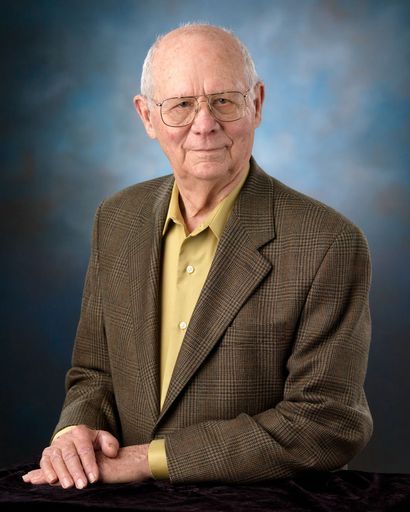

Robert Edwin Smylie
December 25, 1929 — April 21, 2025
Crossville
Robert Edwin (Ed) Smylie was born to Robert and Leona Smylie on a snowy Christmas Day December 25, 1929 at his grandfather’s farm in Lincoln County, Mississippi. He spent his early years in Mississippi and after service in the US Navy graduated from Mississippi State University in 1952 with a bachelor degree in mechanical engineering. He returned to Mississippi State in 1954 where he was an instructor in mechanical engineering and earned a Master’s Degree in mechanical engineering. After college he joined the Douglas Aircraft Company where he was involved in the development of the DC-8. When President Kennedy announced in 1962 plans for a manned mission to the Moon he applied and was accepted for a position with NASA and was appointed as head of the Environmental Control Section. John Glenn made his historic flight 10 days after Ed arrived.
Ed spent the next 11 years shoulder to shoulder with other steely-eyed missile men at the Johnson Space Center in Houston during NASA’s glory years. His primary duties were the design and development of the environmental control systems for the Apollo program including the spacecraft and space suits to be used on all Apollo Lunar Missions. In 1967, he was selected to attend the Sloan Fellowship program at MIT graduating with a Master’s Degree in Management. He later served as Chairman of the working group responsible for working with the Soviet Union for the development of the environmental systems for the joint US-Soviet Apollo-Soyuz mission.
The world held its breath during the Apollo 13 mission as the astronauts and ground support wrestled with seemingly intractable problems. One such problem concerned the CO2 scrubbers used on the command module and lunar module. The two systems used filters that were not interchangeable, and when the entire crew moved into the lunar module, its scrubbing system lacked the capacity to provide breathable air. Ed and two colleagues stepped into the breach to engineer a device that adapted the command module’s scrubbers using only what was available to the crew – among other things a sock, the flight plan binder, hoses from their suits, and duct tape. He later stated that once he learned that duct tape was available, “I felt like we were home free; one thing a southern boy will never say is ‘I don’t think duct tape will fix it.’”
In 1973 he moved to NASA Headquarters in Washington DC and then in 1976 moved to the Goddard Space Flight Center in Greenbelt MD as the Deputy Director. At Goddard he led the development of the Tracking and Data Relay Satellite System (TDRSS). NASA had long depended on a system of ground stations located around the world, some in countries with unreliable governments, to maintain communication with orbiting spacecraft. The TDRSS consisted of three satellites that vastly improved this capability. In 1980 he returned to NASA Headquarters as Associate Administrator for Space Tracking and Data Systems with responsibility for NASA’s worldwide satellite tracking network and NASA communication systems and for data acquisition from satellites.
Ed was an integral contributor at NASA through the early phases of the space shuttle program, and was recognized at a White House luncheon for his role in the program. After retiring from NASA in 1983, he joined RCA as Vice President for Government Communication Systems and in 1988 joined MITRE Corporation as Division Director for NASA Business. He left MITRE in 1990 to join the Grumman Corporation as Vice President for Systems Engineering where he was part of the International Space Station team. He served in this position for several years but then returned to MITRE where he worked until 1995. In his “retirement” he continued to be involved in advancing the space program as an independent consultant until his full retirement in in 2010.
Having served most of his career as the manager of major projects, in retirement he happily assumed the role of laborer under the direction of his wife Carolyn as she tended to their beautiful yard. When not laboring in the yard he enjoyed time on the lake or golf course with friends and family. His grandchildren all have wonderful memories of going out on his boat or joining him on the golf course, as well as going on hikes in the many nearby state parks where he loved showing off the waterfalls.
Ed Smylie passed away peacefully on April 21, 2025 in Crossville, Tennessee having spent 95 years on Earth. He is survived by his children Steve Smylie (of Kitty Hawk, North Carolina), Susan Smylie (of San Antonio, Texas), Lisa Willis and her husband Geoff (of Oklahoma City, Oklahoma), Carolyn’s children Natalie Hall and her husband Gary Hill (of Gainesville, Texas) and Andrew Hall and his wife Kathy Hall (of Tallahassee, Florida), and by his twelve grandchildren and fifteen great grandchildren. He was preceded in death by his wife of 41 years, Carolyn Smylie, his brother John Warren Smylie, his stepson Richard Hall and his former wife June Smylie. Although he is known for his historic accomplishments with NASA, his family knew him as a loving father and grandfather who will be dearly missed. Ad Astra, Ed Smylie. The world has lost someone special. A private celebration of life will be scheduled at a later date.
Guestbook
This site is protected by reCAPTCHA and the
Google Privacy Policy and Terms of Service apply.
Service map data © OpenStreetMap contributors

